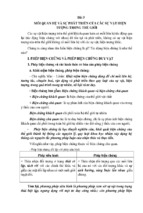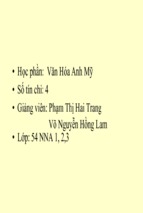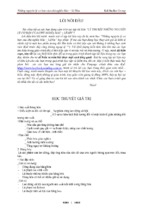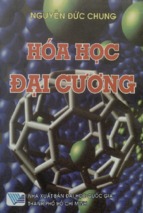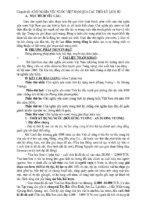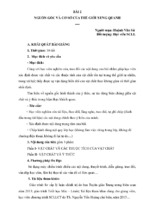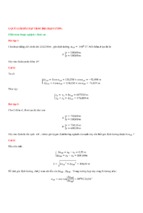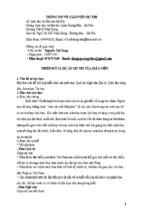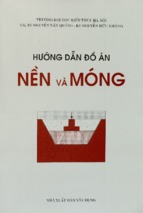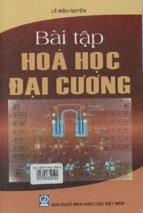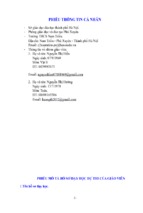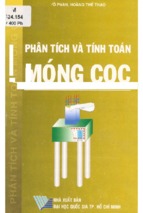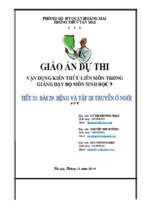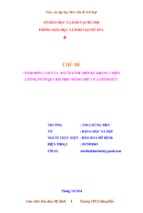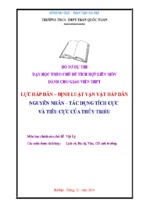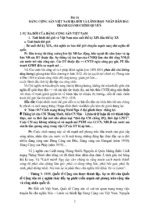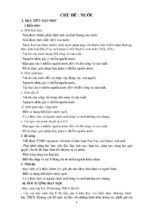Downloaded from ascelibrary.org by RMIT UNIVERSITY LIBRARY on 01/03/19. Copyright ASCE. For personal use only; all rights reserved.
Geotechnical
Earthquake
Engineering and
Soil Dynamics V
Numerical Modeling and
Soil Structure Interaction
GSP 292
Papers from Sessions of Geotechnical
Earthquake Engineering and Soil Dynamics V
EDITED BY
Austin, Texas
June 10–13, 2018
Scott J. Brandenberg, Ph.D., P.E.
Majid T. Manzari, Ph.D.
Downloaded from ascelibrary.org by RMIT UNIVERSITY LIBRARY on 01/03/19. Copyright ASCE. For personal use only; all rights reserved.
GEOTECHNICAL
SPECIAL
PUBLICATION
NO.
292
GEOTECHNICAL EARTHQUAKE
ENGINEERING AND SOIL DYNAMICS V
NUMERICAL MODELING AND SOIL STRUCTURE
INTERACTION
SELECTED PAPERS FROM SESSIONS OF GEOTECHNICAL
EARTHQUAKE ENGINEERING AND SOIL DYNAMICS V
June 10–13, 2018
Austin, Texas
SPONSORED BY
Geo-Institute of the American Society of Civil Engineers
EDITED BY
Scott J. Brandenberg, Ph.D., P.E.
Majid T. Manzari, Ph.D.
Published by the American Society of Civil Engineers
Downloaded from ascelibrary.org by RMIT UNIVERSITY LIBRARY on 01/03/19. Copyright ASCE. For personal use only; all rights reserved.
Published by American Society of Civil Engineers
1801 Alexander Bell Drive
Reston, Virginia, 20191-4382
www.asce.org/publications | ascelibrary.org
Any statements expressed in these materials are those of the individual authors and do not
necessarily represent the views of ASCE, which takes no responsibility for any statement
made herein. No reference made in this publication to any specific method, product, process,
or service constitutes or implies an endorsement, recommendation, or warranty thereof by
ASCE. The materials are for general information only and do not represent a standard of
ASCE, nor are they intended as a reference in purchase specifications, contracts, regulations,
statutes, or any other legal document. ASCE makes no representation or warranty of any
kind, whether express or implied, concerning the accuracy, completeness, suitability, or
utility of any information, apparatus, product, or process discussed in this publication, and
assumes no liability therefor. The information contained in these materials should not be used
without first securing competent advice with respect to its suitability for any general or
specific application. Anyone utilizing such information assumes all liability arising from such
use, including but not limited to infringement of any patent or patents.
ASCE and American Society of Civil Engineers—Registered in U.S. Patent and Trademark
Office.
Photocopies and permissions. Permission to photocopy or reproduce material from ASCE
publications can be requested by sending an e-mail to
[email protected] or by locating a
title in ASCE's Civil Engineering Database (http://cedb.asce.org) or ASCE Library
(http://ascelibrary.org) and using the “Permissions” link.
Errata: Errata, if any, can be found at https://doi.org/10.1061/9780784481479
Copyright © 2018 by the American Society of Civil Engineers.
All Rights Reserved.
ISBN 978-0-7844-8147-9 (PDF)
Manufactured in the United States of America.
Geotechnical Earthquake Engineering and Soil Dynamics V GSP 292
Preface
Downloaded from ascelibrary.org by RMIT UNIVERSITY LIBRARY on 01/03/19. Copyright ASCE. For personal use only; all rights reserved.
This volume is one of four Geotechnical Special Publications (GSPs) containing papers
from the Fifth Geotechnical Earthquake Engineering and Soil Dynamics Conference:
(GEESDV) held in Austin, Texas during June 10–13, 2018. The GEESDV is the latest
event in a series of highly successful conferences held in Sacramento CA (2008),
Seattle WA (1998), Park City UT (1988), and Pasadena CA (1978). The conference is
organized by the Earthquake Engineering and Soil Dynamics Technical Committee of
the Geo-Institute (G-I) of the American Society of Civil Engineers (ASCE) and brings
together practicing geo-professionals, researchers, and students from around the world
to share the latest advances, engineering applications, and pedagogical approaches in
this discipline.
This Geotechnical Special Publication is the outcome of two years of concerted efforts
by the conference lead organizers and the members of the “technical program” and
“proceedings” committees. All submitted papers were reviewed and accepted by at
least two independent peer-reviewers. The final accepted technical papers are
organized in the following special publications:
Volume 1: Liquefaction Triggering, Consequences, and Mitigation
Volume 2: Seismic Hazard Analysis, Earthquake Ground Motions, and RegionalScale Assessment
Volume 3: Numerical Modeling and Soil Structure Interaction
Volume 4: Slope Stability and Landslides, Laboratory Testing, and In Situ Testing
The Editors would like to express their sincere appreciation to the members of the
technical program and proceedings committees as well as the session chairs and
reviewers.
The Editors,
Scott J. Brandenberg, Ph.D., P.E., M.ASCE
Majid T. Manzari, Ph.D., M.ASCE
Acknowledgments
The organizing committee would like to thank the authors, reviewers, session chairs,
ASCE staff, and OmniPress staff, without whom this publication would not be possible.
GEESDV Conference Program Committee
Conference Chair
Ellen M. Rathje, Ph.D., P.E., F.ASCE, University of Texas at Austin
© ASCE
iii
Geotechnical Earthquake Engineering and Soil Dynamics V GSP 292
Conference Co-Chair
Adrian Rodriguez-Marek, Ph.D., M.ASCE, Virginia Tech
Downloaded from ascelibrary.org by RMIT UNIVERSITY LIBRARY on 01/03/19. Copyright ASCE. For personal use only; all rights reserved.
Technical Program Chair
Scott J. Brandenberg, Ph.D., P.E., M.ASCE, University of California Los Angeles
Proceedings Chair
Majid T. Manzari, Ph.D., M.ASCE, George Washington University
Technical Program Committee
Shideh Dashti, Ph.D, AM.ASCE, University of Colorado at Boulder
Ramin Motamed, Ph.D., P.E., M.ASCE, University of Nevada, Reno
Scott M. Olson, Ph.D., P.E., M.ASCE, University of Illinois
Brady R. Cox, Ph.D., P.E., A.M.ASCE, University of Texas
Proceedings Committee
Tong Qiu, Ph.D., P.E., M.ASCE, Pennsylvania State University
Namasivayam (Sathi) Sathialingam, Ph.D, P.E., G.E., D.GE., F.ASCE, Fugro
Consultants, Inc.
Mahdi Taiebat, Ph.D., P.E., M.ASCE, University of British Columbia
Short Course / Student Programs Co-Chairs
Dimitrios Zekkos, Ph.D., P.E., M.ASCE, University of Michigan
Christopher E. Hunt, Ph.D., P.E., G.E., M.ASCE, Geosyntec Consultants
Student and Younger Member Activities Chair
Menzer Pehlivan, Ph.D., P.E., M.ASCE, CH2M
Sponsorships and Exhibits Chair
Thaleia Travasarou, Ph.D., P.E., G.E., M.ASCE, Consultant
GEESDV Topics and Session Chairs
Liquefaction Triggering, Consequences, and Mitigation
Katerina Ziotopoulou, Ph.D., A.M.ASCE, University of California, Davis
Shideh Dashti, Ph.D., A.M.ASCE, University of Colorado at Boulder
Brett Maurer, Ph.D., A.M.ASCE, University of Washington
Mourad Zeghal, Ph.D., A.M.ASCE, Rensselaer Polytechnic Institute
Laurie G. Baise, Ph.D., M.ASCE, Tufts University
Kevin W. Franke, Ph.D., P.E., M.ASCE, Brigham Young University
Arash Khosravifar, Ph.D., P.E., M.ASCE, Portland State University
© ASCE
iv
Geotechnical Earthquake Engineering and Soil Dynamics V GSP 292
Soil Structure Interaction
Anne Lemnitzer, Ph.D., A,M.ASCE, University of California, Irvine
Armin W. Stuedlein, Ph.D., P.E., M.ASCE, Oregon State University
Downloaded from ascelibrary.org by RMIT UNIVERSITY LIBRARY on 01/03/19. Copyright ASCE. For personal use only; all rights reserved.
Ground Motion and Site Response
Dong Youp Kwak, Ph.D., RMS
James Kaklamanos, Ph.D., A.M.ASCE, Merrimack College
Albert R. Kottke, Ph.D., P.E., M.ASCE, Pacific Gas and Electric
Ramin Motamed, Ph.D., P.E., M.ASCE, University of Nevada, Reno
Regional Scale Assessment of GeoHazards
Qiushi Chen, Ph.D., A.M.ASCE, Clemson University
Seismic Hazard Assessment
Sebastiano Foti, Ph.D., Politecnico di Torino
Recent Advances In Situ Site Characterization
Thaleia Travasarou, Ph.D., G.E., M.ASCE, Fugro Consultants, Inc.
Seismic Slope Stability and Landslides
Jennifer Donahue, Ph.D., P.E., M.ASCE, JL Donahue Engineering, Inc.
Jack Montgomery, Ph.D., A.M.ASCE, Auburn University
Recent Advances in Numerical Modeling
Giuseppe Buscarnera, Ph.D., Aff.M.ASCE, Northwestern University
Mahdi Taiebat, Ph.D., P.Eng, M.ASCE, University of British Columbia
Majid T. Manzari, Ph.D., M.ASCE, The George Washington University
Usama S. El Shamy, Ph.D., P.E., M.ASCE, Southern Methodist University
Recent Advances in Laboratory Testing
Inthuorn Sasanakul, Ph.D., P.E., M.ASCE, University of South Carolina
Brad P. Wham, Ph.D., A.M.ASCE, University of Colorado
Scott M. Olson, Ph.D., P.E., M.ASCE, University of Illinois, Urbana
Mark Stringer, Ph.D., M.ASCE, University of Canterbury
© ASCE
v
Geotechnical Earthquake Engineering and Soil Dynamics V GSP 292
Contents
Downloaded from ascelibrary.org by RMIT UNIVERSITY LIBRARY on 01/03/19. Copyright ASCE. For personal use only; all rights reserved.
Plenary Topics
On the Modeling of Soils after the Onset of Liquefaction ....................................................... 1
Pedro Arduino
Numerical Modeling
A Constitutive Model Controlling Damping for 2D and 3D Site Response .......................... 17
Samuel Yniesta and Scott J. Brandenberg
A Modified Uniaxial Bouc-Wen Model for the Simulation of Transverse
Lateral Pipe-Cohesionless Soil Interaction ............................................................................ 25
Kien T. Nguyen and Domniki Asimaki
A Practical 3D Bounding Surface Plastic Sand Model for Geotechnical
Earthquake Engineering Application..................................................................................... 37
Zhao Cheng
Analysis of the Contractive Behavior of Soil Deposits Subjected to Biaxial
Excitation................................................................................................................................. 48
Vicente Mercado, Mourad Zeghal, and Omar El-Shafee
Assessment of Soil-Structure-Fluid Interaction of a Digester Tank Complex
in Liquefiable Soils under Earthquake Loadings .................................................................. 57
Deepak Rayamajhi, Dario Rosidi, Michele McHenry, and Nathan M. Wallace
Assessment of Vulnerability Curves of Pircas over Slopes by the Discrete
Element Method (DEM)—A Case Study in Carabayllo, Peru .............................................. 66
Criss Zanelli, Sandra Santa Cruz, Noelia Valderrama, and Dominique Daudon
Capabilities and Limitations of Different Numerical Tools in Capturing
Seismic Site Performance in a Layered Liquefiable Site ....................................................... 79
Jenny Ramirez, Andres R. Barrero, Long Chen, Alborz Ghofrani, Shideh Dashti,
Mahdi Taiebat, and Pedro Arduino
Cyclic Multi-Directional Response of Clay Deposits: Evaluating a
Constitutive Model .................................................................................................................. 89
H. Nouri, C. Rutherford, and G. Biscontin
Cyclic Shearing Response of Granular Material in the Semi-Fluidized
Regime ................................................................................................................................... 100
Andres R. Barrero, William Oquendo, Mahdi Taiebat, and Arcesio Lizcano
© ASCE
vi
Geotechnical Earthquake Engineering and Soil Dynamics V GSP 292
Data Analytics Applied to a Microscale Simulation Model of Soil
Liquefaction........................................................................................................................... 108
Usama El Shamy and Michael Hahsler
Downloaded from ascelibrary.org by RMIT UNIVERSITY LIBRARY on 01/03/19. Copyright ASCE. For personal use only; all rights reserved.
Discrepancy Metrics and Sensitivity Analysis of Dynamic Soil Response .......................... 115
Mourad Zeghal, Nithyagopal Goswami, Majid Manzari, and Bruce Kutter
Discrete Element Simulation of Soil Liquefaction: Fabric Evolution,
Large Deformation, and Multi-Directional Loading ........................................................... 123
Gang Wang, Duruo Huang, and Jiangtao Wei
Effectiveness of Ground Improvement in Sands upon Seismic Loading
Using Non-Linear Soil Model ............................................................................................... 133
Sparsha Nagula and Jürgen Grabe
Energy Dissipation in Soil Structure Interaction System .................................................... 142
Han Yang, Yuan Feng, Sumeet K. Sinha, Hexiang Wang,
and Boris Jeremić
Evaluation of Liquefaction Case Histories from the 2010–2011 Canterbury
Earthquakes Using Advanced Effective Stress Analysis ..................................................... 152
Nikolaos Ntritsos, Misko Cubrinovski, and Aimee Rhodes
Evaluation of the ISA-Hypoplasticity Constitutive Model for the
LEAP-2017 Project ............................................................................................................... 165
William Fuentes, Vicente Mercado, and Carlos Lascarro
Fragility Assessment of Transportation Infrastructure Systems Subjected to
Earthquakes .......................................................................................................................... 174
Sotiris Argyroudis, Stergios Mitoulis, Amir M. Kaynia, and Mike G. Winter
Fragility Based Seismic Performance Assessment of Buried Structures ............................ 184
Wenyang Zhang, Abdoul R Ghotbi, Elnaz E. Seylabi, Payman K. Tehrani,
Alp Karakoc, Richard Gash, and Ertugrul Taciroglu
General Equation and Simplified Model to Predict Damping Properties of
Clays Using Soil Plasticity ..................................................................................................... 193
Behzad Amir-Faryar and M. Sherif Aggour
Implementation, Validation, and Application of PM4Sand Model in PLAXIS .................. 200
Gregor Vilhar, Anita Laera, Federico Foria, Abhishek Gupta,
and Ronald B. J. Brinkgreve
Modeling Delayed Flow Liquefaction Initiation after Cyclic Loading ................................ 212
Zhenhao Shi, Ferdinando Marinelli, and Giuseppe Buscarnera
Numerical Simulation of the Seismic Response of Gravity Retaining Walls ...................... 221
Usama El Shamy and Aliaksei Patsevich
© ASCE
vii
Geotechnical Earthquake Engineering and Soil Dynamics V GSP 292
Downloaded from ascelibrary.org by RMIT UNIVERSITY LIBRARY on 01/03/19. Copyright ASCE. For personal use only; all rights reserved.
Partially Saturated Soil: Formulation through Generalized Fluid Vector
and Validation with Leaking Test ........................................................................................ 228
S. Iai
Prediction of Three-Dimensional Dynamic Soil-Pile Group Interaction in
Layered Soil by Boundary Element Analysis and Seismic Cone Penetration
Tests ....................................................................................................................................... 237
Zhiyan Jiang and Jeramy C. Ashlock
Selective Filtering of Numerical Noise in Liquefiable Site Response Analyses................... 248
Yannis Z. Tsiapas and George D. Bouckovalas
Simplified Method for Nonlinear Soil-Pile Interactions in Two Dimensional
Effective Stress Analysis ....................................................................................................... 258
Y. Tamari, O. Ozutsumi, K. Ichii, and S. Iai
Simplified Soil-Pile Interaction Modeling under Impact Loading ...................................... 269
Mojdeh Asadollahi Pajouh, Jennifer Schmidt, Robert W. Bielenberg,
John D. Reid, and Ronald K. Faller
SSI versus SSSI for Adjacent Pump Stations in San Francisco .......................................... 281
Kirk C. Ellison, Armin Masroor, Sue Chen, William Liang, Tina Kwan,
Bessie Tam, and Martin Walker
Soil Structure Interaction
A Nonlinear Model Inversion to Estimate Dynamic Soil Stiffness of
Building Structures ............................................................................................................... 293
Hamed Ebrahimian, S. Farid Ghahari, Domniki Asimaki,
and Ertugrul Taciroglu
A Quasi-Static Displacement-Based Approximation of Seismic Earth
Pressures on Rigid Walls ...................................................................................................... 300
Joaquin Garcia-Suarez and Domniki Asimaki
Calibration of a New Pressure Sensor and Application to a Dynamic Soil
Structure Interaction Study .................................................................................................. 312
Anne Lemnitzer and Lohrasb Keykhosropour
Centrifuge Modeling to Evaluate Kinematic Soil-Foundation-Structure
Interaction ............................................................................................................................. 321
Amin Borghei and Majid Ghayoomi
Comparison of Experimental and Computational Snap-Back Responses of
Driven Steel Tube Piles in Stiff Clay .................................................................................... 330
M. J. Pender, L. S. Hogan, and L. M. Wotherspoon
© ASCE
viii
Geotechnical Earthquake Engineering and Soil Dynamics V GSP 292
Comparison of Pseudo-Static Limit Equilibrium and Elastic Wave Equation
Analyses of Dynamic Earth Pressures on Retaining Structures ......................................... 340
Nathaniel Wagner and Nicholas Sitar
Downloaded from ascelibrary.org by RMIT UNIVERSITY LIBRARY on 01/03/19. Copyright ASCE. For personal use only; all rights reserved.
Dynamic Stresses in Foundation Soils beneath Strip Footings ............................................ 351
Bahareh Heidarzadeh, Jonathan P. Stewart, and George Mylonakis
Evaluation of the Influence of Frequency Characteristics of Input
Earthquake on Seismic Coefficient for Gravity Quay Wall via
Dynamic Centrifuge Tests..................................................................................................... 361
Moon-Gyo Lee, Jeong-Gon Ha, Heon-Joon Park, and Dong-Soo Kim
Factors Affecting the Torsional Response of Deep Foundations ......................................... 368
Qiang Li and Armin W. Stuedlein
Field Experiment of Rocking Shallow Foundation on Cohesive Soil
Subjected to Lateral Cyclic Loads ........................................................................................ 379
Keshab Sharma and Lijun Deng
Inertial and Liquefaction-Induced Kinematic Demands on a
Pile-Supported Wharf: Physical Modeling .......................................................................... 388
Milad Souri, Arash Khosravifar, Stephen E. Dickenson, Scott Schlechter,
and Nason McCullough
Interactive Web Application for Computing Seismic Earth Pressure ................................ 398
Nikolaos P. Machairas, Magued G. Iskander, and Mehdi Omidvar
Investigating Implications of Induced Seismicity on Wind Turbine
Foundations ........................................................................................................................... 407
Eric Ntambakwa, Ian Prowell, and Carlos Guzman
Investigation of Rocking Mechanism of Shallow Foundation via
Centrifuge Tests .................................................................................................................... 416
Kil-Wan Ko, Jeong-Gon Ha, Heon-Joon Park, and Dong-Soo Kim
Key Parameters for Predicting Residual Tilt of Shallow-Founded
Structures Due to Liquefaction............................................................................................. 425
Zach Bullock, Zana Karimi, Shideh Dashti, Abbie Liel, and Keith Porter
Pile Driving Vibration Attenuation Relationships: Overview and
Calibration Using Field Measurements ................................................................................ 435
Athina Grizi, Adda Athanasopoulos-Zekkos, and Richard D. Woods
Response of Hybrid Monopile-Friction Wheel Foundation under
Earthquake Loading Using Centrifuge Modelling .............................................................. 445
Xuefei Wang, Xiangwu Zeng, and Xinyao Li
© ASCE
ix
Geotechnical Earthquake Engineering and Soil Dynamics V GSP 292
Downloaded from ascelibrary.org by RMIT UNIVERSITY LIBRARY on 01/03/19. Copyright ASCE. For personal use only; all rights reserved.
Seismic Bearing Capacity of a Strip Footing Situated on Soil Slope
Using a Non-Associated Flow Rule in Lower Bound Limit Analysis .................................. 454
K. Halder, D. Chakraborty, and S. K. Dash
Uplift Analysis of an Underground Structure in a Liquefiable Soil
Subjected to Dynamic Loading ............................................................................................. 464
Priya Beena Sudevan, A. Boominathan, and Subhadeep Banerjee
Winkler Stiffness Intensity for Flexible Walls Retaining Inhomogeneous
Soil ......................................................................................................................................... 473
Maria Giovanna Durante, Scott J. Brandenberg, Jonathan P. Stewart,
and George Mylonakis
© ASCE
x
Geotechnical Earthquake Engineering and Soil Dynamics V GSP 292
On the Modeling of Soils after the Onset of Liquefaction
Pedro Arduino, Ph.D., M.ASCE1
1
Downloaded from ascelibrary.org by RMIT UNIVERSITY LIBRARY on 01/03/19. Copyright ASCE. For personal use only; all rights reserved.
Dept. of Civil and Environmental Engineering, Univ. of Washington, Seattle, WA 98005.
E-mail:
[email protected]
ABSTRACT
Catastrophic infrastructure failures frequently are frequently caused by the dynamic
interaction of soil and water. Earthquake induced liquefaction, high-water induced levee failures,
bridge scour, and rainstorm-induced slides are all examples of such phenomena involving
various time and space scales. In many cases, engineering techniques for predicting onset of
failures are available and widely used in practice, but there is a dearth of tools available for more
general consideration of post-failure behavior. Modeling behavior up to and beyond the point of
failure is complicated by the fact that the overall material response involves complex interactions
between solid and liquid phases and transitions from solid behavior to sediment transport.
Frameworks designed for use in either solid-only or fluid-only contexts are not capable of
tracking the significant phenomena throughout a given event history. The early work of Biot, and
subsequent adoption of mixture theories, facilitated the development of coupled finite element
applications capable of representing the response of saturated and partially saturated soils. This
together with the development of constitutive models capable of representing the contractive and
dilative response of soils enhanced the predictive capabilities of liquefaction and lateral
spreading in the context of a deforming soil/water domain. However, these advancements are
limited to moderately small deformations and situations where the fluid and solid domains
coexist in a smeared domain. Advances in experimental work at multiple scales create an
opportunity to revisit and expand existing constitutive models to incorporate fabric information
at the micro-scale and provide physical data to validate computational models at the macro-scale.
Meshless techniques like SPH and MPM help mitigate mesh distortion at large deformation
providing suitable techniques for lateral spreading and other phenomena like debris flow where
mixing and separation is relevant. This paper reviews a few of these aspects indicating trends,
opportunities and challenges, and ventures into the prospects of future liquefaction simulation.
THE MULTIPHASE NATURE OF SOILS
Geomaterials, in particular soils, consist of assemblages of particles with different sizes and
shapes which form a skeleton (porous matrix) whose voids are filled with water or other liquids
and air or gas. The word “soil”, therefore, implies a mixture of assorted mineral grains with
various fluids (i.e. a multi-phase material).
The study of this type of material is of great importance in applied civil engineering,
particularly in geotechnical engineering. The design of foundations for vibrating machines, the
study of propagating earthquake impulses in geologic materials, and the catastrophic loss of
strength of a soil associated with the increase of pore water pressure known as ``liquefaction'' are
examples of geotechnical problems where the analysis of the response of multi-phase materials
(i.e. soils or porous media) becomes important. The importance of this subject has been
recognized since the early 1940's, when the apprehension of the colossal devastation caused by
major earthquakes created the need to better understand its possible effects in order to mitigate
higher losses that could be avoided by adequate engineering design.
© ASCE
1
Downloaded from ascelibrary.org by RMIT UNIVERSITY LIBRARY on 01/03/19. Copyright ASCE. For personal use only; all rights reserved.
Geotechnical Earthquake Engineering and Soil Dynamics V GSP 292
During the last four decades significant progress has been made in understanding the
behavior of a porous matrix interacting with one or more fluids. In the area of geotechnical
engineering three approaches are identified: (1) field observations prior, during, and after
earthquakes, (2) laboratory experimentation, and (3) theoretical/numerical studies. Among the
last group three different philosophies have emerged: decoupled methods (or total stress
approach), indirectly coupled methods (quasi-effective stress approach), and fully coupled
methods (or effective stress approach).
This paper focuses on the use of fully coupled methods of analysis, which are based on the
theory of mixtures. The premise of these theories is that a mixture may be viewed as a
superposition of ``n'' individual continua, each following its own motion.
In the light of these theories, the behavior of porous media cannot be described directly,
since, in general, it is not possible to know a priori which spatial position will be occupied by
which particular constituent. For this reason, substitute continuum models must be used to
replace the particulate structure, where a single material (component) is assumed to occupy the
total region. The use of volume fraction theories constitutes the necessary connection between
global bulk average quantities and the local effective quantities. Figure 1 shows a schematic of a
typical Representative Elementary Volume (REV) for a porous media where volume fractions
n(s) = n and n(f) = 1-n are defined using Equations (1) (where n = porosity) (Arduino & Macari
2001).
Figure 1: Typical Representative Elementary Volume (REV)
V ( )
; n( ) 1
V
(1)
V(f)
V (s) V V ( f )
(f)
(s)
n
n; n
1 n
V
V
V
Within this framework the problem generally leads to geometrical and physical nonlinear
relations. In order to obtain a simple and practical theory, further simplifications must be
introduced. For this reason a mixture composed of only two constituents, i.e., the porous matrix
and a saturating fluid, is considered. The different components are assumed to share a common
temperature with a vanishing temperature gradient. Furthermore, the compressibility of the solid
particles is assumed to be much smaller than the compressibility of the body as a whole and the
deviator stress in the media fluid is assumed to be negligible in comparison to that in the solid's
skeleton. Finally, the development of the constitutive equations is many times restricted to the
case of small strains.
n( )
GOVERNING EQUATIONS OF A SOIL-FLUID MIXTURE
When considering a mixture of a solid interacting with a fluid the continuum balance
equations are:
© ASCE
2
Geotechnical Earthquake Engineering and Soil Dynamics V GSP 292
3
Equation of motion - Solid phase
(1 n)s xi( s ) (1 n)s xi(,sj) x (js ) (1 n)s bi( s )
n 2f (k sf )ij1 ( x (js ) x (j f ) ) ij'(,sj) (1 n) p,i 0
Downloaded from ascelibrary.org by RMIT UNIVERSITY LIBRARY on 01/03/19. Copyright ASCE. For personal use only; all rights reserved.
Equation of motion - Fluid phase
nf xi( s ) nf xi(, fj ) x (j f ) nf bi( s )
(2)
n 2f (k sf )ij1 ( x (js ) x (j f ) ) np,i 0
Equation of motion - Mixture
n
p (1 n) xi(,si ) nxi(,if ) 0
Kf
In these equations the balance of mass for the mixture results from the combination of the
balance of mass for the solid and fluid phases and assumes the fluid is compressible, with bulk
modulus Kf. The resulting set of equations is equivalent to Biot’s field equations for an inert
mixture composed of a porous solid skeleton and a saturating Newtonian fluid and includes
interaction forces and convective terms for the solid and fluid motions. Biot established these
equations years before the theory of mixture was postulated by Truesdell in 1960.
Solution of this system of differential equations may be obtained using approximate methods
of analysis. Among these, the Finite Element (FE) method is most frequently used in the
literature. Proceeding along standard FE lines a weak formulation associated with the governing
field equations for a saturated porous media may be obtained, (Arduino & Macari 2001 a and b).
A solution for the weak formulation can be obtained using a spatial semi-discretization of the
domain W into non-overlapping finite element followed by an appropriate time stepping process
applicable to the discretized set of equations. In 1984 Zienkiewickz et al. proposed two and three
field finite element formulations of the generalized Biot equations, (Zienkiewicz 1984).These
have become to be known as the u-U, u-p, and u-p-U formulations, depending on the
independent variables chosen in the approximation scheme, and constitute the basic skeleton of
most commercial and open-source FE numerical platforms used in today’s geotechnical
engineering practice. As an example the open-source numerical platform OpenSees includes 2D
and 3D coupled elements formulated based on the u-p approximation (Opensees 2007). A critical
component in these platforms is the constitutive model used to resolve the nonlinear stress-strain
response of the solid fraction.
CONSTITUTIVE MODELS
Material (constitutive) models play a vital role in the solution of the differential equations
discussed above. As such, an enormous amount of research has gone into their development and
application. While the complexity of these models varies significantly, the primary goal of each
is the same: to capture and replicate material response observed in the field and in the laboratory.
Quite often this boils down to identifying key components that are decisive or fundamental in
predicting a material’s behavior when subjected to a given loading.
The present state of constitutive modeling in soil plasticity is quite advanced. The first
fundamental advances towards developing this field were made in the fifties and early sixties,
and consist of the Drucker-Prager generalization of the Coulomb frictional criterion for soils, and
the Critical State Soil Mechanics (CSSM) framework and associated Cam-Clay type of models.
© ASCE
Downloaded from ascelibrary.org by RMIT UNIVERSITY LIBRARY on 01/03/19. Copyright ASCE. For personal use only; all rights reserved.
Geotechnical Earthquake Engineering and Soil Dynamics V GSP 292
With the increased requirement of earthquake resisting design it became imperative to capture
the soil response under cyclic loading conditions. This requirement is basically accounted for by
the fundamental property of plasticity to be able to simulate the reverse loading response after
pre-loading in one direction. This demand prompted the development of new, more advanced,
soil plasticity models, such as nested surfaces models, kinematic hardening models, bounding
surface models and many others, all of them addressing mainly the cyclic loading response.
Unfortunately, the mathematical sophistication/complexity of advanced soil plasticity models
resulted in the need of calibrating large number of parameters many of them with no direct
physical meaning or parameters difficult to measure using conventional sensors in experimental
(or field) settings. Moreover, since most of today’s advanced models are 3D in nature they
require validation and verification using experimental results that follow general stress paths.
Figure 2 shows experimental results from a 3D cubic device using a variety of stress paths
intended to stimulate material response that could be used to develop (and/or improve) model
functionality and help calibrate model parameters.
Figure 2: Useful experimental stress paths: (a) Undrained constant total mean stress, p, (b)
cyclic simple shear, (c) constant deviatoric q while reducing total mean stress p, and
(d)circular path with constant deviatoric q and constant total mean stress p
In the context of liquefiable soils several models for cyclic loads have been extended to
account for contraction and dilation and the phase transformation phenomena observed during
cyclic loads at small mean effective stresses. A complete description of all these models is
beyond the scope of this paper. Here as an example only the Manzari-Dafalias (MD) model
(Dafalias et al. 2004) is described. The MD model is a bounding surface model capable of
producing stress-strain relationships for both denser-than-critical and looser-than critical sands. It
is also capable of capturing critical state conditions where shear strains accumulate at constant
volume. Its kinematic hardening evolution law is based on basic bounding surface principles as
© ASCE
4
Downloaded from ascelibrary.org by RMIT UNIVERSITY LIBRARY on 01/03/19. Copyright ASCE. For personal use only; all rights reserved.
Geotechnical Earthquake Engineering and Soil Dynamics V GSP 292
postulated by Dafalias and others (Dafalias 1982). An important feature of the MD model is the
dependence of the deviatoric strain direction on the Lode angle which makes the model capable
of capturing sand behavior under stress paths other than those of conventional triaxial
compression or extension. Figure 3 shows schematics of the MD dilation, critical and bounding
surfaces in deviatoric and principal stress spaces, as well as, experimental cubic triaxial results
showing recorded plastic flow directions at different Load angles that validate the shape of the
MD surfaces.
Figure 3, (a) Manzari Dafalias surfaces in deviatoric and principal stress spaces, (b)
Experimental results validating shape of yield and bounding surface.
Figure 4: Manzari Dafalias simulations at different densities and drained and undrained
conditions.
The MD constitutive model is made compatible with critical state soil mechanics through
dependence of the bounding surface and phase transformation surfaces on the value of effective
volumetric stress (p) and void ratio (e) at the current state of the material (see Figure 4). For this
purpose the so called state parameter, defined as ψ = e−ec by Been and Jefferies (Been 1985), is
used to represent the state of the material relative to the critical state line. To account for
softening of denser-than-critical sands and continuous accumulation of deviatoric strain at
constant volumetric strain at critical state, the so called bounding and dilatancy surfaces are tied
to the critical state surface through the state parameter. This proves to be very effective in
simulating the behavior of sands with different densities and under different effective confining
pressures using a single set of material parameters. Finally the behavior of sands during load
reversals and cyclic loading is tied to a fabric tensor that evolves during loading and reloading.
© ASCE
5
Downloaded from ascelibrary.org by RMIT UNIVERSITY LIBRARY on 01/03/19. Copyright ASCE. For personal use only; all rights reserved.
Geotechnical Earthquake Engineering and Soil Dynamics V GSP 292
For a detailed description of the MD material model, the reader is referred to (Dafalias et al.
2004).
The MD model has been used in multiple contexts. In recent years researchers have
attempted to modify the MD formulation to improve different aspects of the model. For example,
Pisanò and Jeremić tried to add viscous damping to compensate for the lack of low strain
damping in the original formulation (Pisano et al. 2014). Recently, Boulanger and Ziotopoulou
modified the model to better capture the general behavior of sands and improve the calibration
process by reducing the number of parameters that needs to be calibrated. They also improved
some of fundamental features, namely the evolution of the fabric tensor (Boulanger et al. 2013).
This model is referred as PM4Sand in the literature. Figure 5 (a) and (b) show comparisons
between PM4Sand simulations and cyclic stress experimental results for an Ottawa-F65 sand.
Figure5(c) shows good agreement between simulated and recorded number of cycles to
liquefaction for different relative densities and cyclic stress ratios.
Figure 5: Comparison between PM4Sand simulations and experimental results: (a) stress
path, (b) stress-strain curves and (c) numerical vs experimental number of cycles to
liquefaction.
Although very useful the MD model, as well as all models for liquefiable soils, suffer from
the inherent limitation they have to transition from solid to fluid behavior and back. During
liquefaction the soil matrix collapses and the solid particles become suspended in water. Under
this condition the solid-water mixture begins to behave like a viscous fluid. Mathematical models
obviously must account for the “metamorphosed” soil behavior – i.e. solid-like during the preliquefaction stage, and liquid-like during the liquefaction stage. Modeling of such phenomena is
not straightforward, and some researchers propose one might switch to particulate mechanics, or
discrete element modeling to account for such disparate behaviors. In general, however,
switching a solution from continuum model to a micromechanical model is awkward and
cumbersome. A logical approach is to use continuum models all the way and utilize the
particulate mechanics approach only to determine the overall properties of soils in the liquefied
stage. In here the role of soil micromechanics, in addition to providing a fundamental insight into
the particulate nature of soils, is to provide overall effective properties of the granular assembly
as well (e.g., overall moduli, viscosity, etc.) for use with continuum-based models. In this regard
great progress has been made in recent years using advanced DEM techniques to represent solid
particles and the help of CT scanning images on samples subjected to monotonic and cyclic
loads (see Andrade et al. 2012).
© ASCE
6
Geotechnical Earthquake Engineering and Soil Dynamics V GSP 292
Downloaded from ascelibrary.org by RMIT UNIVERSITY LIBRARY on 01/03/19. Copyright ASCE. For personal use only; all rights reserved.
FINITE ELEMENT SIMULATION
Although useful to understand basic behavior, the end goal of constitutive models is to be
implemented in general numerical platforms for the solution of boundary value problems. For
example the current OpenSees platform distribution includes the Manzari-Dafalias model, multiyield models for pressure independent and pressure dependent granular materials (PIMY, and
PDMY) (see Elgamal et al. 2003), the recently proposed PM4Sand, and several versions of the
bounding surface model proposed by Borja and Aimes (1994).
As an example of a the use of an advanced constitutive model and robust finite element
platform a few results from the Liquefaction Experiments and Analysis Projects (LEAP) effort
are discussed. LEAP is aimed at producing high quality experimental data sets and undertakes a
systematic validation of existing computational models of the dynamic response and liquefaction
of saturated granular soils (Manzari et al. 2014). Within this context, LEAP-GWU 2015 was a
first validation effort using centrifuge tests of a benchmark sloping soil deposit. The centrifuge
experiment was designed to be readily repeatable at multiple centrifuge facilities (Manzari et al.
2014). Specifically, the tests were conducted using “rigid-wall” containers to avoid the
complexity of boundary conditions of laminar boxes. The rigid-walls provide analogous
conditions at different centrifuge facilities, are simpler to simulate in a numerical model, and,
hence, are more appropriate for validation purposes than articulated laminar boxes. The adopted
centrifuge model corresponds to a prototype of a submerged uniform sand deposit with a length
of 20 m and a height decreasing from 4.875 m to 3.125 m (or a 5o sloping surface, Figure 6). A
ramped (up and down) sinusoidal input base motion was prescribed as a target for all the
conducted tests. The same Ottawa F-65 sand was used at all centrifuge facilities and an extensive
set of material and element tests were conducted to characterize this soil and provide data
necessary for constitutive model calibration (see Figure 4).
Figure 6: LEAP Finite Element mesh and location of recorded pore water pressures (P),
accelerations (AH) and displacements (D). Input motion shown at bottom (sinusoidal f =
2Hz)
To assess the capabilities of a few prominent constitutive models and numerical modeling
techniques for soil liquefaction analysis, a series of blind predictions were undertaken by
researchers and practitioners in the USA and Japan. Figure 7 shows comparisons of experimental
results and numerical simulations obtained using OpenSees and the Manzari-Dafalias model
(Ghofrani and Arduino 2016). Figure 7(a) shows acceleration response spectra at locations AH1,
AH3, AH5, AH7, and AH9 and Figure 7(b) excess pore pressure time histories at locations P1,
© ASCE
7
Geotechnical Earthquake Engineering and Soil Dynamics V GSP 292
Downloaded from ascelibrary.org by RMIT UNIVERSITY LIBRARY on 01/03/19. Copyright ASCE. For personal use only; all rights reserved.
P3, P5, P7, and P9. Overall, the predicted response is in good agreement with the observed
response in the centrifuge.
Figure 7: LEAP predictions results for RPI centrifuge experiment: (a) acceleration
response spectra (5% damping) and (b) excess pore water pressures (see Figure 6 for
location of sensors)
Figure 8: LEAP predictions for centrifuge experiments: (a) surface horizontal
displacement near the middle of the specimen, (b) surface vertical displacements at three
locations along the surface (see Figure 6 for location of sensors).
Figure 8 shows ultimate horizontal and vertical displacements at the surface recorded in the
centrifuge (color dots on the right axis) along with the evolution of the corresponding predicted
displacements for two experiments. Although the simulated results are in the range of
displacements observed in the centrifuge, the predicted values represent poorly the large
deformation phenomenon that results after liquefaction. Besides obvious inconsistencies in the
centrifuge tests, other reasons can be enumerated to justify these differences, including changes
© ASCE
8
Downloaded from ascelibrary.org by RMIT UNIVERSITY LIBRARY on 01/03/19. Copyright ASCE. For personal use only; all rights reserved.
Geotechnical Earthquake Engineering and Soil Dynamics V GSP 292
in hydraulic conductivity and void ratio redistribution affecting critical aspects of the constitutive
model and finite element response. However, they also expose other difficulties that become
notorious after the onset of liquefaction; namely the problem of using small deformation theories
at the constitutive level and mesh distortion at the finite element level.
Once liquefaction is triggered, or during liquefaction incursions at small mean stresses, the
soil deformations are large and therefore the small strain approximation (i.e., the norm of
displacement gradient is small when compared to unity) is not valid anymore. This requires
alternative finite deformation measures based on finite deformation theories, which unlike small
deformation theory, can be formulated in either the initial or deformed configuration. As such,
there are typically additional complexities associated with constitutive laws and care must be
taken to ensure frame indifference and objectivity e.g., Truesdell and Noll (1965); Marsden and
Hughes (1983). Although there are ways to extend small strain implementations into the finite
deformations regime, most of the existing models for liquefaction are structured using small
strain theory simplifications difficult to modify. Among all possible deformation measures the
left Cauchy-Green deformation tensor provides the basis for a return mapping algorithm that is
remarkably similar to frameworks commonly used for small deformation measures.
THE PROBLEM OF LARGE DEFORMATIONS
Possible Numerical Strategies - Meshless Techniques
Even when using well defined constitutive models that account for large deformations, the
ensuing finite element simulations may still suffer from exaggerated mesh distortion that limit
their applicability in practice. This is a well know problem difficult to resolve using conventional
finite element techniques. To alleviate this problem several alternative methodologies can be
used including Arbitrary Lagrangian-Eulerian (ALE) methods, both Lagrangian and Eulerian
Finite Element Methods (FEM), meshless or meshfree methods including the Material Point
Method (MPM) and Smooth Particle Hydrodynamics (SPH), and select Finite Difference (FD)
techniques. A thorough literature review would include a detailed comparison of all these
numerical methods. However, this is beyond the scope of this work. Therefore, in this paper we
limit to a brief comparison between MPM and SPH and discuss MPM more in detail; in part due
to the experience of the author on the use of this method.
The Material Point Method
The Material Point Method (MPM) is a numerical technique that is best suited for modeling
history dependent materials in a dynamic, large deformation setting. The formulation tracks
moving points relative to stationary nodes, and can be used to capture the behavior of both fluids
and solids in a unified framework. The standard, or traditional, implementation solves the
governing equation of motion at fixed nodes that collectively form a grid. Each body or phase in
the analysis is represented by a collection of discrete points known as material points or particles
(Sulsky et al. 1995). This general concept is shown in Figure 9 (a). In MPM each body in the
analysis is represented by a series of discrete points known as material points or particles. The
different components that make up a simulation are classified as either Body- or Domain/GridBased. The Body-Based group is comprised of the continuum body itself and the computational
points that collectively describe the object. Each particle represents a portion of the total mass,
and thus carries an implied volume as well as state variables that depend on the application. In
geotechnical applications each material point is assigned a position, velocity, stress, strain, and
© ASCE
9

